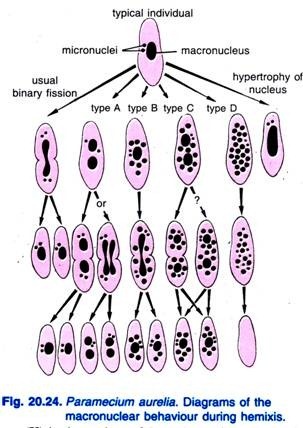In this article we will discus about the organization of plant mitochondrial DNA.
The mitochondrial genome of higher plants is the largest and complex among the eukaryotes. However, the plant mitochondrial genome does not contain many genes. The complex nature of plant mitochondrial genome might be due to the presence of many chloroplast sequences in the mtDNA of higher plants.
As mitochondria have their own DNA, transcription and translation takes place for the synthesis of relatively small set of polypeptides mainly focused in ATP production. Mitochondria use slightly a different genetic code. Most of the genes for mitochondrial proteins are present in nuclear DNA, translated in cytosol and consequently to mitochondria.
The circular mitochondrial DNA in plants has a buoyant density of about 1.705 gmL-1 in caesium chloride. This actual figure corresponds to approximately 47% G + C. There is a considerable size difference between the mitochondrial DNA among various organisms and ranges from 16 kb in humans to over 2010 kb in muskmelon.
The mitochondrial size in Brassica campestris is 218 kb and contains direct repeat of 2000 kb, whereas in Zea mays, there are five direct repeat and inverted repeat sequence present in 570 kb DNA (Table 5.3). The size of ribosomal RNA (26 S and 18 S) in plant mitochondria is larger than other mitochondria and there is a unique 5 S rRNA in higher plants.
The closely linked 18 S and 5 S genes in maize are separated from the gene for 25 S rRNA. The rRNA sequence in plant mitochondria has several homologies with bacterial and chloroplast rRNA genes. Several evidences have shown that DNA sequences can move from one organelle to another organelle. In maize, 12 kb chloroplast sequences have been shown to be inserted into mitochondrial DNA.
The plant mitochondrial genes that encode proteins for cytochrome C oxidase and the apoprotein of cytochrome b have been sequenced. Understanding of DNA sequence of other corresponding genes led to the conclusion that mitochondria do not use the universal genetic code and uses various other alternatives, for example, in maize mitochondria CGG codes for tryptophan. However, this codon represents for arginine in universal code. Plant mitochondrial genes seem to lack UGA termination codon.
In maize mitochondria, a gene for the apoprotein of cytochrome b is 1164 base pairs long and codes for protein of 42.9 kD and its amino acid sequence exhibits almost fifty per cent homology with other corresponding proteins in yeast. The presence of introns in maize genes was not evidenced.
The exact nature on the processing of mitochondrial DNA is not known. It is however, believed that 5′ end is not capped and no extensive poly-adenylation. Many plants fail to produce fertile pollen; as a consequence, plants exhibit male sterility, which is controlled by nuclear and mitochondrial genes.
Analysis of maize genome suggests that genes present in the mitochondria determine cytoplasmic male sterility, and its sterility problem can be reversed back by nuclear restorer (Rf) genes. It is often difficult to identify the sequences responsible for cytoplasmic male sterility (cms) due to the larger size of mitochondrial DNA.
In Brassica napus, there are several cms-associated Open Reading Frame (ORF) associated with male sterility, for example, orf224/atp6 locus linked to male sterility for cms associated mitochondrial genes provide strong evidence that Turf 13 gene is responsible for cms in T-cytoplasm maize. Cytoplasmic male sterility has been studied in maize and has been distinguished into four general types like N, T, C and S.
The normal (N) type gives rise to functional pollen whereas T, C and S are male sterile. The mitochondrial genome of the male sterile S-cytoplasm of maize contains the repeated DNA region R, which contains two chimeric ORF. Protoplast fusion experiment has been conducted to identify cms-associated gene of petunia. Functions of genes associated with cytoplasmic male sterility.
